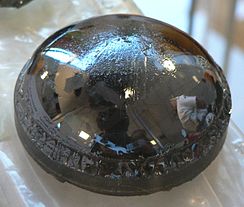This is an old revision of this page, as edited by Beetstra (talk | contribs) at 09:34, 6 December 2011 (Saving copy of the {{chembox}} taken from revid 464212901 of page Silicon_carbide for the Chem/Drugbox validation project (updated: '').). The present address (URL) is a permanent link to this revision, which may differ significantly from the current revision.
Revision as of 09:34, 6 December 2011 by Beetstra (talk | contribs) (Saving copy of the {{chembox}} taken from revid 464212901 of page Silicon_carbide for the Chem/Drugbox validation project (updated: '').)(diff) ← Previous revision | Latest revision (diff) | Newer revision → (diff)| This page contains a copy of the infobox ({{chembox}}) taken from revid 464212901 of page Silicon_carbide with values updated to verified values. |

| |
| Names | |
|---|---|
| Preferred IUPAC name Silicon carbide | |
| Systematic IUPAC name Methanidylidynesilylium | |
| Other names
Carborundum Moissanite | |
| Identifiers | |
| CAS Number | |
| 3D model (JSmol) | |
| ChEBI | |
| ChemSpider | |
| EC Number |
|
| Gmelin Reference | 13642 |
| MeSH | Silicon+carbide |
| PubChem CID | |
| RTECS number |
|
InChI
| |
SMILES
| |
| Properties | |
| Chemical formula | CSi |
| Molar mass | 40.096 g·mol |
| Appearance | Colorless crystals |
| Density | 3.21 g/cm (all polytypes) |
| Melting point | 2,730 °C (4,950 °F; 3,000 K) |
| Electron mobility | ~900 cm/(V·s) (all polytypes) |
| Refractive index (nD) | 2.55 (infrared; all polytypes) |
| Hazards | |
| NFPA 704 (fire diamond) |
 |
| Except where otherwise noted, data are given for materials in their standard state (at 25 °C , 100 kPa).
| |
Chemical compound
- Patnaik, P. (2002). Handbook of Inorganic Chemicals. McGraw-Hill. ISBN 0070494398.
- Cite error: The named reference
ioffewas invoked but never defined (see the help page).